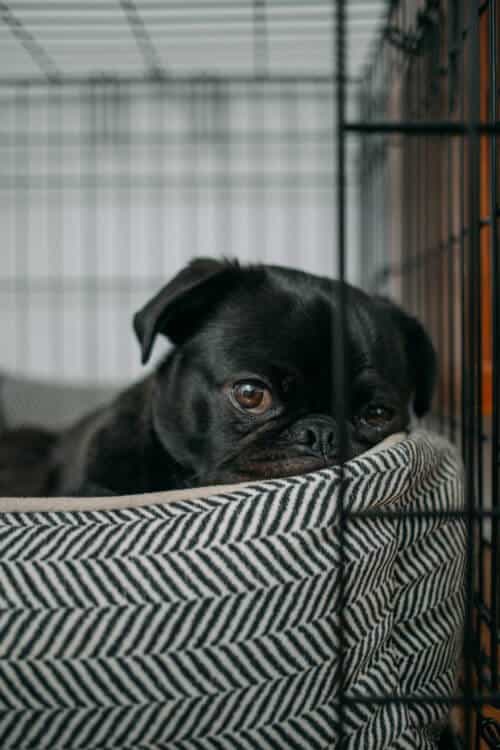Are pugs in pain? This is a common question coming from pet owners. Being a vet is a tough job because your patient can’t speak.
Things are not simple for pet owners either, no matter how well they know their companion’s normal behavior.
They have to look at very subtle signs suggesting health issues. Pets can express their pain by displaying a variety of confusing symptoms.
These symptoms include restlessness, changes in sleep patterns, behavioral changes, aggressivity, and abnormal posture.
As the owner of a dog breed such as the pug, you need to pay extra attention. Pugs are more prone to health issues compared to other breeds.
Knowing the common ailments affecting your canine’s health will make it easier for you to tell when they are suffering.
Are pugs in pain or discomfort?

Here are the main health issues that can affect pugs and how you can prevent or alleviate those problems:
1. Pugs breathing problems
Pugs and breathing issues are almost synonymous. Before getting this dog breed you absolutely need to get informed on pugs breathing problems and what causes them.
The reason why people like pugs is the same for pugs breathing fast while sleeping or pugs breathing attacks.
Their smushed faces look adorable, but in medical terms, they are a brachycephalic breed and this causes several health problems.
Brachycephalic describes a short head with a squished face and a short nose.
Their anatomy differs by having an abnormally small windpipe (trachea). This may prevent them from breathing properly under certain circumstances.
How To Handle Pugs Breathing Attacks
- Hot weather
When dogs overheat, they have several strategies for cooling off. They keep their tongues hanging out of their mouths and pant to bring more air into their upper respiratory system.
This strategy is meant to evaporate water from their mucous membranes since dogs don’t have sweat glands.
The problem is that with brachycephalic breeds, smaller noses make it difficult to get extra air into the dog’s body.
Watch for signs of discomfort such as loud snorting noises and shallow breathing. Help your pug by taking it to a cooler spot and/or offering a cooling pad.
- Overweight
Check this pug weight chart from Cambridge BOAS Research Group to find out how much your pug should weigh.
Reduce food intake and get your pug to exercise more if the pooch is on the hefty side.
- Allergies
Allergic reactions can also cause pugs’ breathing problems. The most common allergens are food, airborne, or from physical contact with certain materials and substances.
Common signs of an allergic reaction are wheezing, coughing, sneezing, and trouble breathing.
- Old age
Breathing problems are more frequent in older pugs and they can become more sensitive to heat or allergens.
- Excitement
This dog breed can also have breathing difficulties when getting overly excited. This can happen in situations such as playing with their favorite toy or playing with a dog they like.
You need to remove the source of excitement until they calm down, even if this can be very hard.
2. Bone and joint problems
Pugs can suffer from a variety of musculoskeletal issues, which often cause pain and suffering. These problems can also be a source of expensive vet bills.
Depending on its genetic baggage and environmental factors, your pug can be affected by the following ailments:
- Hip and elbow dysplasia
This inherited disease causes joints to develop improperly and eventually results in arthritis.
Stiffness in the dog’s elbow and hips and difficulty getting up from lying down are two common symptoms.
Doctors can treat arthritis to reduce pain and also recommend maintaining your dog within healthy weight limits.
Those extra pounds your pug may have can lead to the onset of arthritis a lot earlier.
- Legg-Calve-Perthes disease
Legg-Calve-Perthes disease (LCPD) is a hip disorder caused by a disruption of blood flow to the head of the femur. The bone dies due to a lack of blood flow. (source)
Healing occurs when new blood vessels infiltrate the dead bone, but the femoral head remains weakened.
In dogs, LPCD usually occurs between 6 and 9 months of age, causes pain, and usually requires surgery.
- Patellar luxation
Patellar luxation occurs when your pug’s kneecap slips out of place.
You will notice the dog limping and possibly kicking its leg out sideways to pop the patella back in place. In severe cases, surgery can be required to realign the kneecap and prevent it from luxating again.
- Spinal deformities
Spinal deformities such as hemivertebrae can cause spinal cord damage, instability, and pain.
This disease occurs more often in screw-tailed breed dogs like the pug.
3. Trauma
Dogs play quite hard and will often limp after a play fight. Signs you have to worry about include persistent limping, swelling of the joint or toes, and inability to bear weight.
The leg can hang unnaturally and you may notice exposed bone or bone sticking out through the skin. The last two symptoms indicate an open fracture.
An open fracture is a medical emergency. The bone can quickly become contaminated with dirt, which will make it very difficult to heal.
Risks include your pug ending up lame for the rest of its life or even having its leg amputated.
Get your pug to the vet if it has one or more of the symptoms described above. Consider putting a muzzle on the dog as it can bite you, even if it has never been aggressive before.
Most pets can be muzzled with a leash, but for brachycephalic dogs like the pug, you need a special gauze.
Make sure you have one of these as you may also need it for vet visits and grooming sessions.
The muzzle keeps both your pug and others safe and is needed in appropriate situations.
4. Bladder and kidney stones
If your pug is passing a kidney stone, the answer to the question “Are pugs in pain?” is definitely yes.
There are multiple types of stones that can form in your pug’s bladder or kidneys. This dog breed is more prone to this type of problem than others.
Kidney stones are a medical emergency if your pug has blood in its urine or has trouble urinating. Calling a vet is vital under these circumstances.
5. Dental problems
Your pug can deal with toothaches the same way we humans do. Unlike us, pets cannot voice their discomfort.
Symptoms are unusual drooling, bad breath, chewing on one side of the mouth, and visible changes in the dog’s mouth.
Unfortunately, dental disease affects 80% of all dogs by age two. Pugs are even more likely to have dental problems.
Dental disease starts with tartar buildup, so you need to keep your dog’s teeth clean and ensure a healthy diet.
Other preventative measures are annual oral examinations and cleanings, avoiding hard bones, and doing your own oral examinations regularly. (source)
6. Ocular problems
Eye issues can be a serious source of pain and discomfort. They can even lead to blindness if not treated immediately.
The main cause of pug eye issues is its naturally protruding eyeballs. They make it look goofy but make it more prone to injuries too.
Check for lesions if your pug seems to have issues in its ocular region. As a precaution, never let your pet ride with its head out of the window.
This is a frequent cause of eye injuries and otitis, another painful health issue affecting the dog’s ears.
Aside from injuries, pug’s eyes can be affected by entropion and dry eye.
Entropion is a condition causing the eyelid to roll inwards. Eyelashes rub against the surface of the eye and cause severe irritation and pain.
Surgical correction easily treats the problem.
In addition, dry eye or keratoconjunctivitis sicca occurs when tear glands do not produce enough fluid and fail to keep eyes moist.
Effects include soreness, itchiness, and eye infections. Your pug will most probably squint, paw at the eyes, and have a thick discharge from the eyes.
The treatment is an ointment that needs to be applied for the rest of the life.
How to Care for a Pug That is in Pain?

First, discover why are pugs in pain and determine the cause at the vet. You will need to carefully follow the doctor’s advice to treat the cause and ensure pain control.
As a dog owner, your responsibilities include:
- Following the proper dosing instructions for prescribed medication;
- Limiting exercise if advised and allowing the pug to rest;
- Monitoring for new or worsening symptoms;
- Applying hot or cold compresses to ensure local pain relief.
Read Also: Best Small Dog Breeds for Emotional Support
The Bottom Line
The causes of pain can vary a lot. Some of these health problems can be managed by the pug’s owner alone. However, there are multiple situations in which the best option is to pay a visit to a trusted vet.
The vet should find the underlying cause of pain and prescribe adequate treatment to keep your canine healthy and happy.
Read Next: Why Is Your Dog Acting Weird

